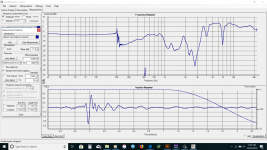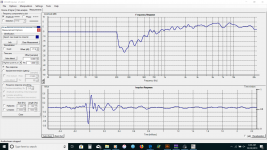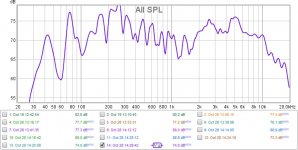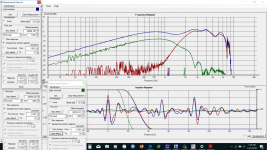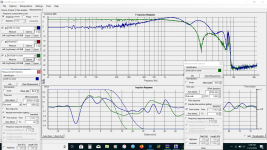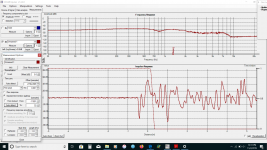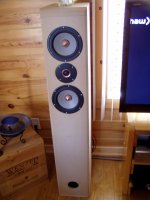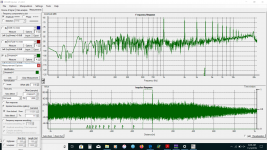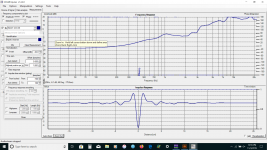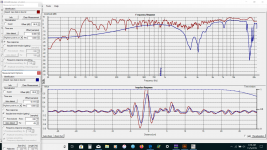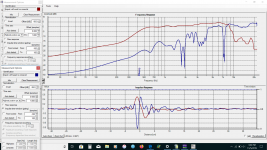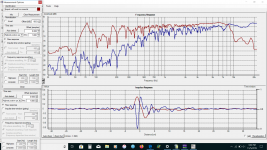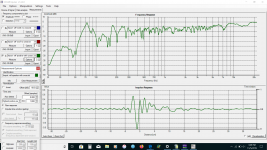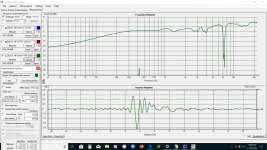No, not saying that. Joe D'Appolito made this configuration popular based on the idea of controlling the dispersion around and through the crossover.I think you are saying that the tm may be easier to build than the mtm
These days it is often simply used as a way to increase the power handling of smaller mid/woofers, also retaining a narrow cabinet, if that's wanted.
Often the only difference is the crossover. One is conventional and the other isn't
It should give the same results, but two caveats here. Firstly, are you using ZMA files, have you measured the impedance magnitude and the impedance phase?not sure if leap is any different than xsim we do not get the same results close though
Then, they may have done a full crossover. The targets will be different.
This could be a worthwhile place to start provided that, the designer went to the same lengths as you would be satisfied with and the enclosure is sufficiently similar. Be cautious about use lesser data to make revisions.I know this may be the easy way out but ... the charts look pretty good.
Higher frequencies are more sensitive to minor response variations. That said, modern capacitors appropriate to speaker crossovers give a substantially similar result to each other. It is readily possible for larger variations to occur due to the crossover design.Just another option. I think the woofer caps can be of lower quality than the tweeter caps?
I have boxes full of them.Do you normally buy a series or several different resistors and caps to be able to make adjustments?
thank you AllenB I spent a considerable amount of time adding the resistors and caps back in and ended up with them out again. I ran the tweeter again without the crossover trying to match the chart you attached earlier. When not gated the FR is close when gated it is quite a bit different. I also tried using the REW sweep and recording it in holms but I don't think Holms can tell the frequency without sending the signal. I should have an adaptor by Friday so can use holms after that. I also tried running with one woofer but that would require more changes to the crossover. The overall FR is not too bad the tweeter has that weird hump from 2k to 6k then starts to roll off. what I do not understand is the tweeter, crossover and cabinet did not change other than to removing the two resistors and the cap but putting them back in did not help. With the other mag drivers the tweeter was virtually flat and rising above 10k how can changing the woofers change the tweeter so much?
Attachments
I can see how it appears this way, but you could be looking at a strong nearby reflection. With more reflections this will appear to average out which may explain why the raw response looks smoother. Your impulse also shows several artifacts above around 5kHz whose source is not clear. Best wait until you get everything set up.I don't think Holms can tell the frequency without sending the signal.
I suspect my tweeter is different to yours.trying to match the chart you attached earlier
Looking at your plots from posts #32 and #35, the woofer is just 12dB down from the tweeter. At least one of the plots had me thinking there was noise in the system causing bad data, but maybe it comes down to a crossover issue.how can changing the woofers change the tweeter so much
Thank you AllenB
I think you are correct best to wait until I can get the testing set up and use holms instead of importing data from REW. hopefully this weekend.
Tne noise could be a television in another room or the dehumidifier kicking on. When I get set up I will eliminate the other noises.
I think you are correct best to wait until I can get the testing set up and use holms instead of importing data from REW. hopefully this weekend.
Tne noise could be a television in another room or the dehumidifier kicking on. When I get set up I will eliminate the other noises.
Hello Allen
I got the device to measure with holms. here is the chart showing the speaker. the woofer pair and the tweeter. all with the crossover. The tweeter makes a strange noise at the top of the sweep. and is not getting to 10000. it is happening on both speakers.
The second chart shows the tweeter and woofer pair without crossover. I am very confused. the tweeter is not right it looks a lot like the woofer. they are wired separately so should not be able to interfere with each other.
not sure how to proceed
thank you
Ben
I got the device to measure with holms. here is the chart showing the speaker. the woofer pair and the tweeter. all with the crossover. The tweeter makes a strange noise at the top of the sweep. and is not getting to 10000. it is happening on both speakers.
The second chart shows the tweeter and woofer pair without crossover. I am very confused. the tweeter is not right it looks a lot like the woofer. they are wired separately so should not be able to interfere with each other.
not sure how to proceed
thank you
Ben
Attachments
Last edited:
Alright I know it is not the tweeter it has to be the measurement system either the spl meter I am using as a mic or the software or the little adapter card. 2000, 14000, 18000 are all within 6db when run as a sign wave and measured I guess that means the spl meter is ok too.
Your measurements are above 0dB. Take a measurement in silence and see where the noise floor is. You may not need to go so high.
Your measurements are fuzzy. This is due to 'from=-11801'. You can still see through this, though it might help in diagnosing the top end.
You have nearby reflections. I can get around 5-6mS (1.7-2m) of reflection free time when measuring free vertical speakers.
Your gating should be striving to get as much time as possible. Looking at your first screenshot, you have a clear and significant reflection at just above 50cm which would normally set a limit. You have three basic options, you can gate just before this, or you can identify that some other earlier input deserves to be cut and gate accordingly, or you can move the obstruction and try again.
Your measurements are fuzzy. This is due to 'from=-11801'. You can still see through this, though it might help in diagnosing the top end.
You have nearby reflections. I can get around 5-6mS (1.7-2m) of reflection free time when measuring free vertical speakers.
Your gating should be striving to get as much time as possible. Looking at your first screenshot, you have a clear and significant reflection at just above 50cm which would normally set a limit. You have three basic options, you can gate just before this, or you can identify that some other earlier input deserves to be cut and gate accordingly, or you can move the obstruction and try again.
Hi Allen
the measurements are offset I read the manual and adjusted the screen instead of the offset. the readings are very hard to understand, I changed the angle on the speaker and these should have less reflection. But the readings are still confusing and gating is still very high this is the full speaker with the crossover. the impulse is confusing and very choppy. the tweeter still is not showing up very well and the sound in not right femaie vocals are a touch forward and screechy not sure exactly how to proceed. thank you again for all of your help.
the measurements are offset I read the manual and adjusted the screen instead of the offset. the readings are very hard to understand, I changed the angle on the speaker and these should have less reflection. But the readings are still confusing and gating is still very high this is the full speaker with the crossover. the impulse is confusing and very choppy. the tweeter still is not showing up very well and the sound in not right femaie vocals are a touch forward and screechy not sure exactly how to proceed. thank you again for all of your help.
Attachments
Hi AllenB
here is a picture from our old house we moved to a house with smaller rooms the current room is 15x13 and 7 ft high basement room the speakers are 9x12.5x49" we now live close to the ocean and solen recommended the Nextel drivers as the mag drivers may corrode again. last night I cranked them up for a short time and they sounded off . i did try to get measurements several times today but they all look pretty much the same. i do not think the tweeter measurement is accurate. when i use a spl meter and just run sine wave at different frequency above 10k I get similar readings to 2k. using the data from REW and running thru xsim it looks like a resistor across L1 on the low side and C2 on the high side may reduce the humps in the 5-8k range and lower the woofers to match the tweeters more closely but I sure would like to have accurate measurements before i start making changes. i am wondering if the usb sound card maybe limiting the range of measurement. thank you again
here is a picture from our old house we moved to a house with smaller rooms the current room is 15x13 and 7 ft high basement room the speakers are 9x12.5x49" we now live close to the ocean and solen recommended the Nextel drivers as the mag drivers may corrode again. last night I cranked them up for a short time and they sounded off . i did try to get measurements several times today but they all look pretty much the same. i do not think the tweeter measurement is accurate. when i use a spl meter and just run sine wave at different frequency above 10k I get similar readings to 2k. using the data from REW and running thru xsim it looks like a resistor across L1 on the low side and C2 on the high side may reduce the humps in the 5-8k range and lower the woofers to match the tweeters more closely but I sure would like to have accurate measurements before i start making changes. i am wondering if the usb sound card maybe limiting the range of measurement. thank you again
Attachments
Instead of plugging into your amp, to test your system you can connect the sound card output back to its input. You should measure flat responses. This is a common procedure.. I also like to do this through my amp, with the output going back to the sound card, however you should take precautions against over voltage. I typically use a voltage divider, but it can be done without it with care.
Does your mic have calibration? Does it need it?
Does your mic have calibration? Does it need it?
So you have a system with drivers spanning vertically around 16", but the significant radiating surfaces are mostly within about 13". If you prop the speaker up so the tweeter is 3.5' off the ground in the middle of the room, and the mic at the same height, 1m apart, the ceiling and floor should be the closest things to the speaker from which sound might reflect.
This means your first reflection should be at 4' (120cm) or 3.5mS. You should gate here, you should see the reflection so you aren't doing it blind.
This means your first reflection should be at 4' (120cm) or 3.5mS. You should gate here, you should see the reflection so you aren't doing it blind.
Hi
thank you I think you guys are onto something with the windows sound card after trying a variety of hookups and going thru the REW manual this is what I have for a sound card reading it is not pretty. this is a direct cable for headphone jack out to usb in
thank you I think you guys are onto something with the windows sound card after trying a variety of hookups and going thru the REW manual this is what I have for a sound card reading it is not pretty. this is a direct cable for headphone jack out to usb in
Attachments
I am still having some issues getting the laptop to work with the sound card. the Mac sound card is considerably better so I used that and REW with the spl meter and the soundcard calibrated. then I dumped the data into Holms and here are the results the speaker is raised up so the speaker is centered in the room. Somehow In the connect and disconnect I must have inverted the tweeter. I will have very limited time to work on it the next couple of weeks. I will run the tweeter and woofer pair separately and keep working on getting the laptop to measure directly into holms. The chart is gated and raw data from the same measurement. I am still not confident in the calibrations and will repeat them. the soundcard cal looks good but the spl cal rolls off 12 db from about 7khz to 20khz and I want to verify that that is correct.
Attachments
I thought I'd share an example, as you sometimes show the raw response and I think I can see the benefit here.
In this plot, the nulls (comb filtering) in the upper half of the response are an intentional part of the design, so I'd expect the raw and gated results to agree there. The point in fact is that the raw and gated responses are mostly in agreement.
This comes from trying to make the gating redundant by eliminating anything that shouldn't be on the measurement.
You are still verifying the integrity of your system, however looking at your latest makes me wonder. If I saw that variation between the plots I would think there was something happening after the impulse and before the gate and due to the short time difference, it may be box related.
In this plot, the nulls (comb filtering) in the upper half of the response are an intentional part of the design, so I'd expect the raw and gated results to agree there. The point in fact is that the raw and gated responses are mostly in agreement.
This comes from trying to make the gating redundant by eliminating anything that shouldn't be on the measurement.
You are still verifying the integrity of your system, however looking at your latest makes me wonder. If I saw that variation between the plots I would think there was something happening after the impulse and before the gate and due to the short time difference, it may be box related.
Attachments
So I think I have the everything calibrated on the mac here is the speaker full with crossover and the woofer and tweeter without crossover gated and raw. I think the next thing to do is to transfer the gated data into xsim and work on a new xover. is that correct? this is on the milk crate so the tweet is about 1/2 the vertical distance. 1 meter
Attachments
- Status
- This old topic is closed. If you want to reopen this topic, contact a moderator using the "Report Post" button.
- Home
- Loudspeakers
- Multi-Way
- Box port or crossover dippity do
